Our Lower FODMAP Gingerbread Pear Upside Down Cake combines a buttery brown sugar and pear topping, with a moist gluten-free gingerbread cake. This cake is not recommended for the Elimination Phase of the low FODMAP diet. Please note the icons at the top of the recipe; this cake is appropriate for those who digest fructose, sorbitol and fructans well as has been determined during your Challenge Phase.
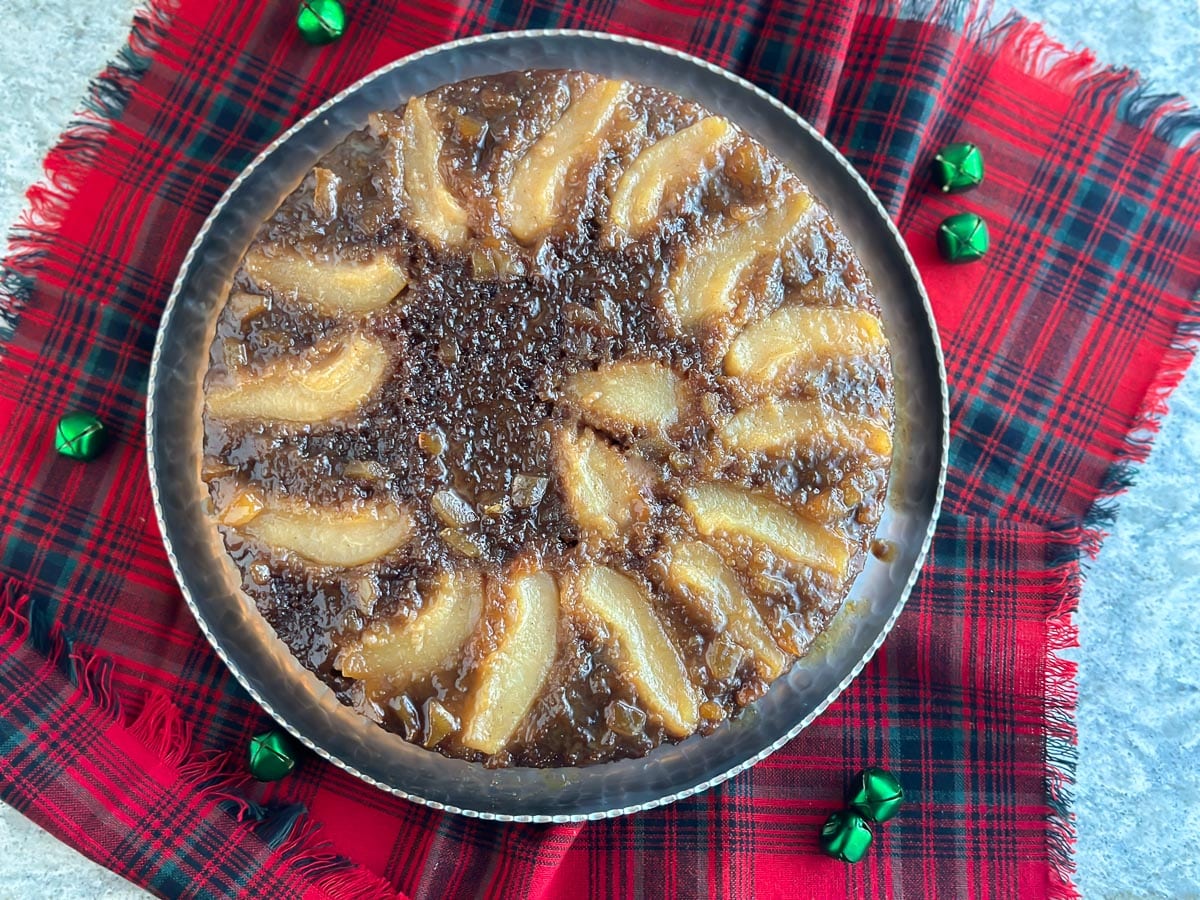
At FODMAP Everyday® we want to support people throughout their low FODMAP diet journey, which means that we have recipes for the Elimination Phase, but also for the highly personalized Integration Phase. The goal of the diet is to eat as broadly as possible for your physical and emotional health, without triggering IBS symptoms. This is best determined by conducting structured Elimination and Challenge Phases, preferably with the help of a FODMAP trained Registered Dietitian. We have a Global Dietitian Directory for you, BTW.
It would be a great time to review our article, How To Use Our Recipe Filter, which further explains our icons, and how you can use it to search for recipes that are appropriate for you and your tolerances.
For those of you who tolerate fructose, sorbitol and fructans, this cake will be a welcomed addition to your repertoire.
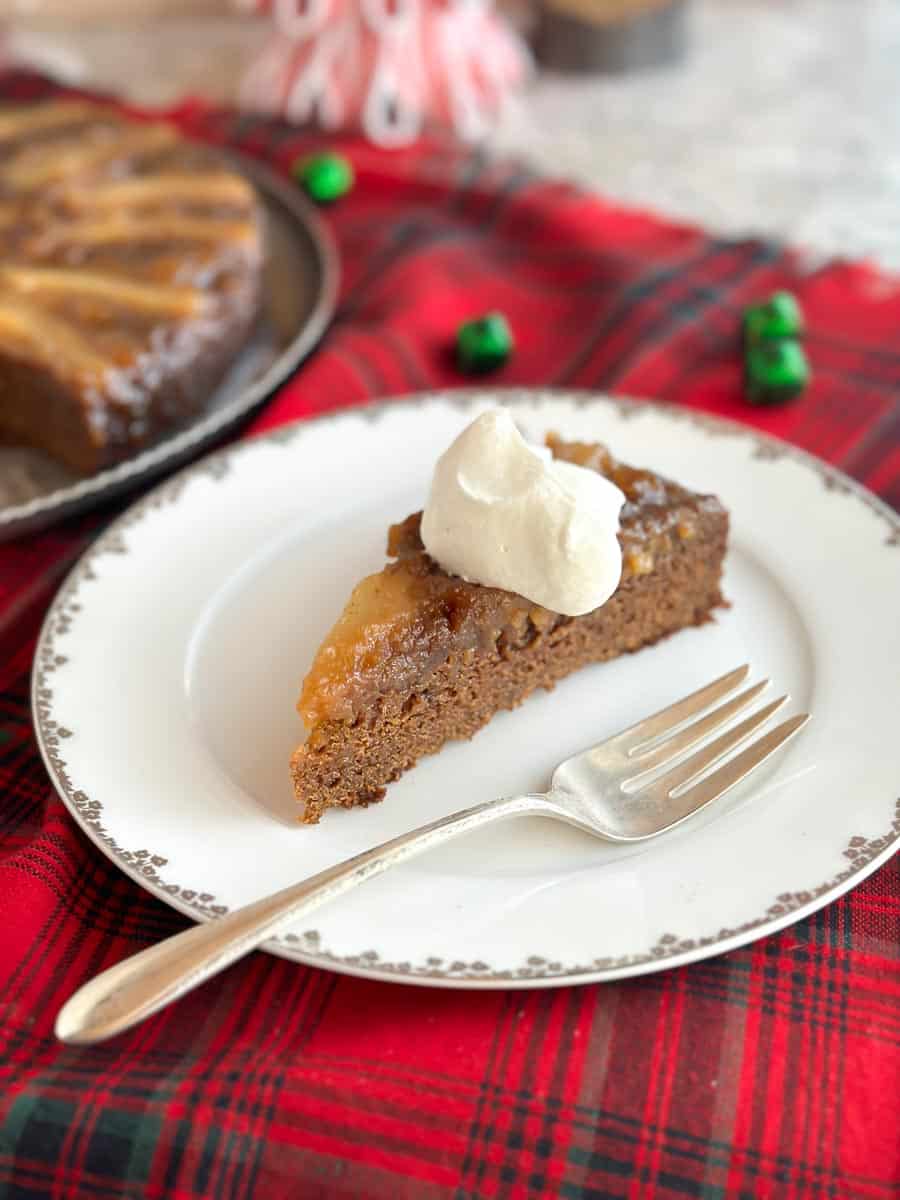
Frequently Asked Questions
Molasses is one of those foods that you might hear is low FODMAP, but it all depends on serving sizes. Both Monash University and FODMAP Friendly have lab tested molasses. Neither details what kind. Their low FODMAP serving sizes range from 3 g to 5 g. The Monash suggested amount of 5 g is equivalent to 1 teaspoon. Molasses contains both fructose and fructans.
Both Monash University and FODMAP Friendly have lab tested Packham pears for FODMAP content. The Monash suggested low FODMAP amount is 5 g; FODMAP Friendly did not come up with any amount that is low FODMAP.
Five grams is a very small amount of pears, and they contain both fructose and sorbitol. This is why this recipe is labeled at the top, with our exclusive icons, as a recipe that can be enjoyed by those who already know their tolerances to sorbitol, fructose, and fructans and digest them well.
The diet is low FODMAP, and not “no” FODMAP. The diet is also 3 phases. During the last phase you will be integrating foods into your diet that you have assessed, during the Challenge Phase, as foods that you tolerate. You are still eating a lower FODMAP diet, but it is tailored to you.
We do not recommend this cake for the Elimination Phase.
Note that we suggest canned pears, which you use drained. FODMAPs are water soluble, and chances are the pears are lower FODMAP than fresh pears, but we do not know by how much, since they have not been lab tested.
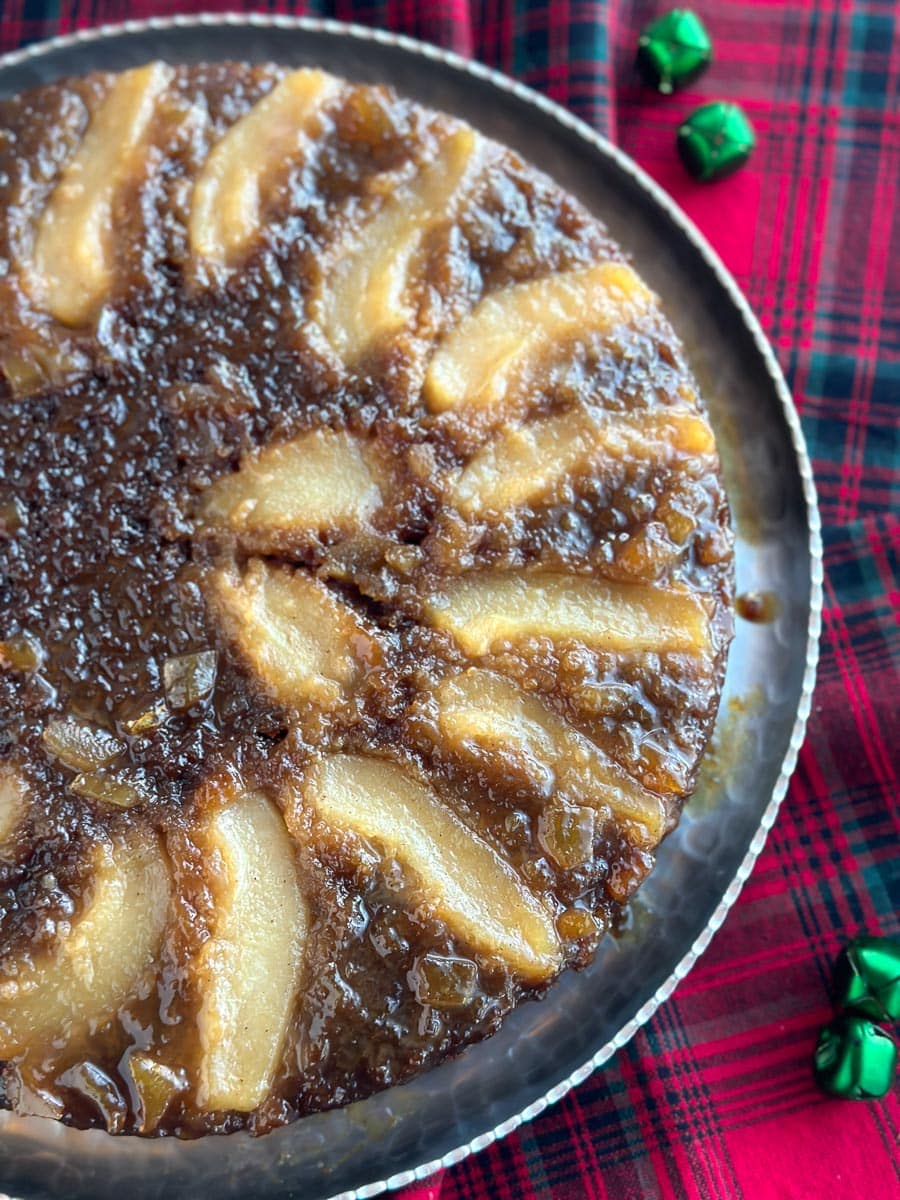
How to Make Lower FODMAP Gingerbread Pear Upside Down Cake
Position oven rack in middle of oven. Preheat oven to 350°F (180°C). Have a flat serving platter available that is at least 12-inches (30.5 cm) across.
For the Pear Topping: Coat a 10-inch (25 cm) round baking pan with nonstick spray.
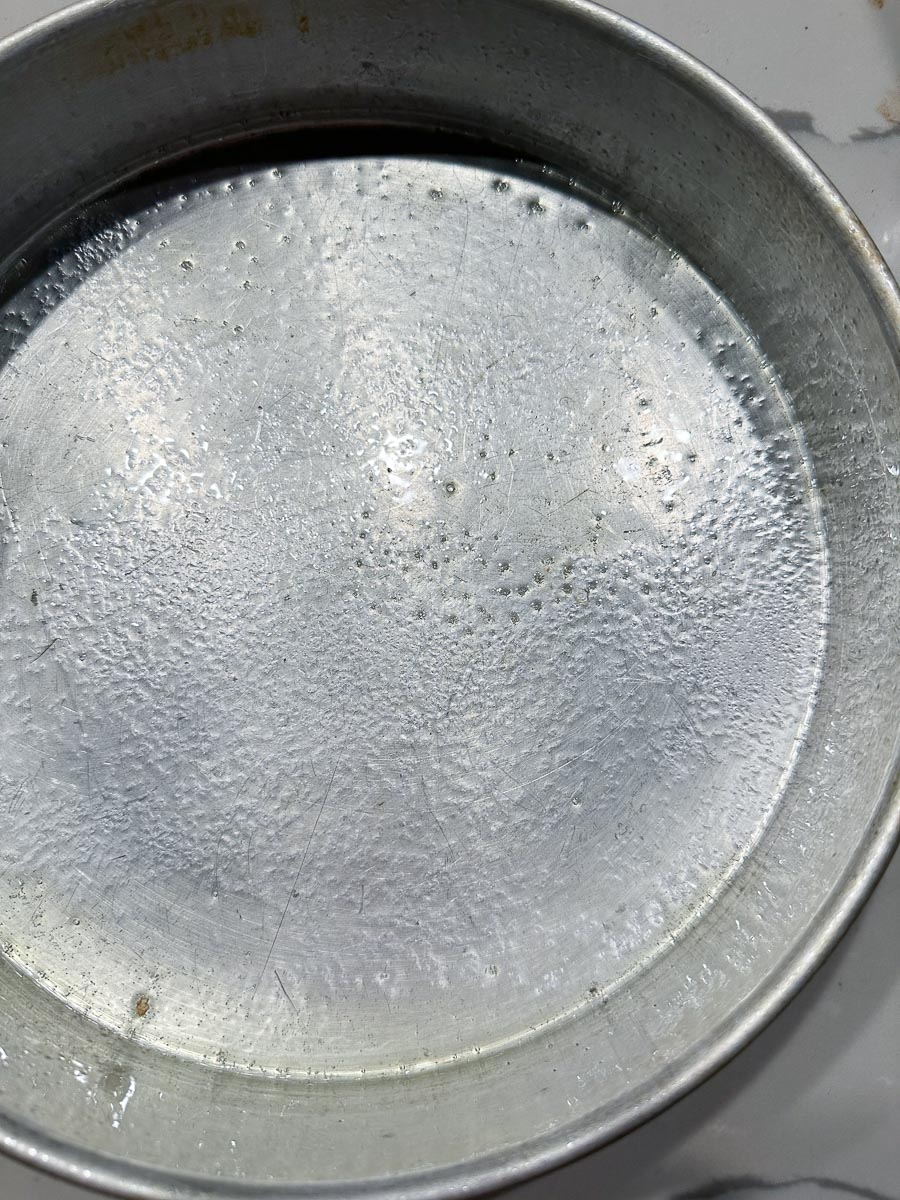
Place butter, brown sugar, and allspice in a small saucepan and melt and bring to a simmer over medium heat, stirring occasionally.
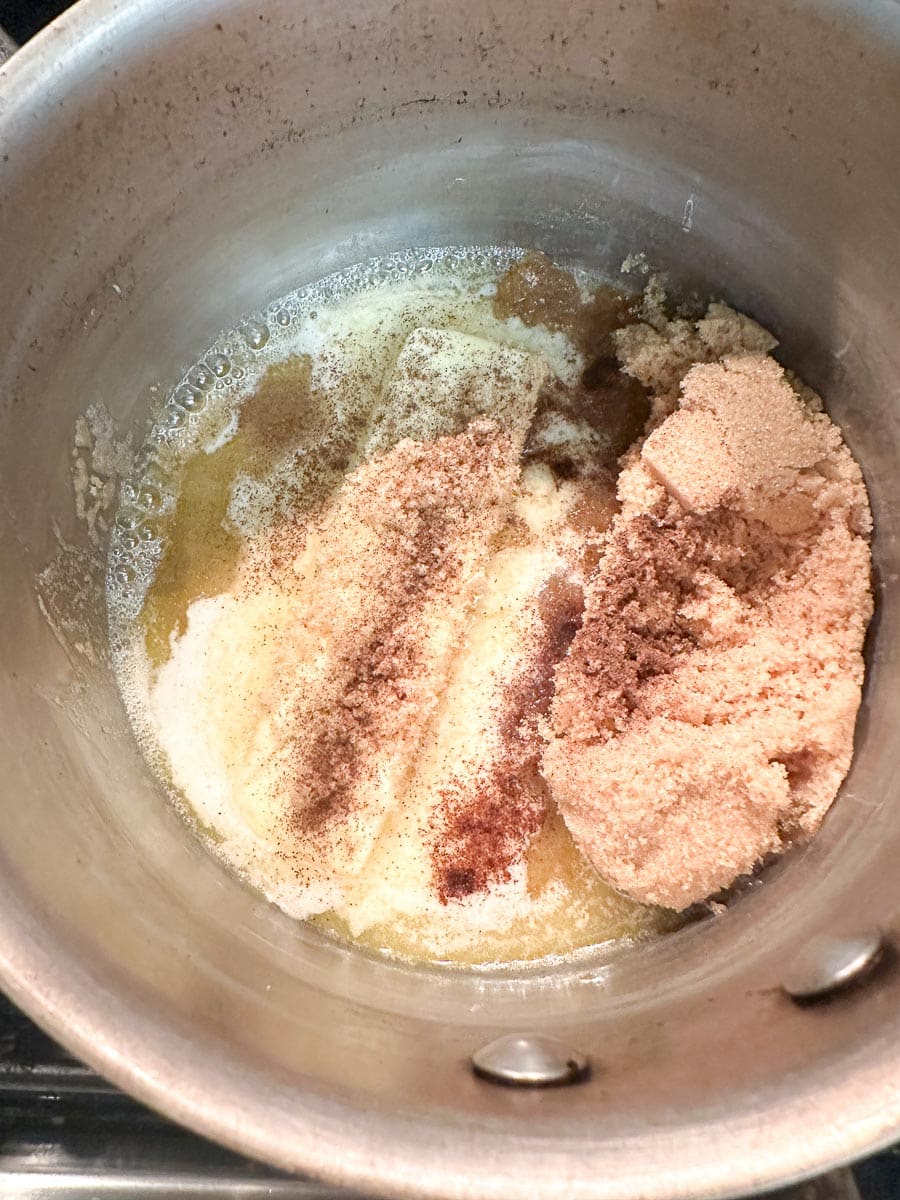
Once it simmers, whisk vigorously for about 30 seconds to combine well. It should look a bit creamy.
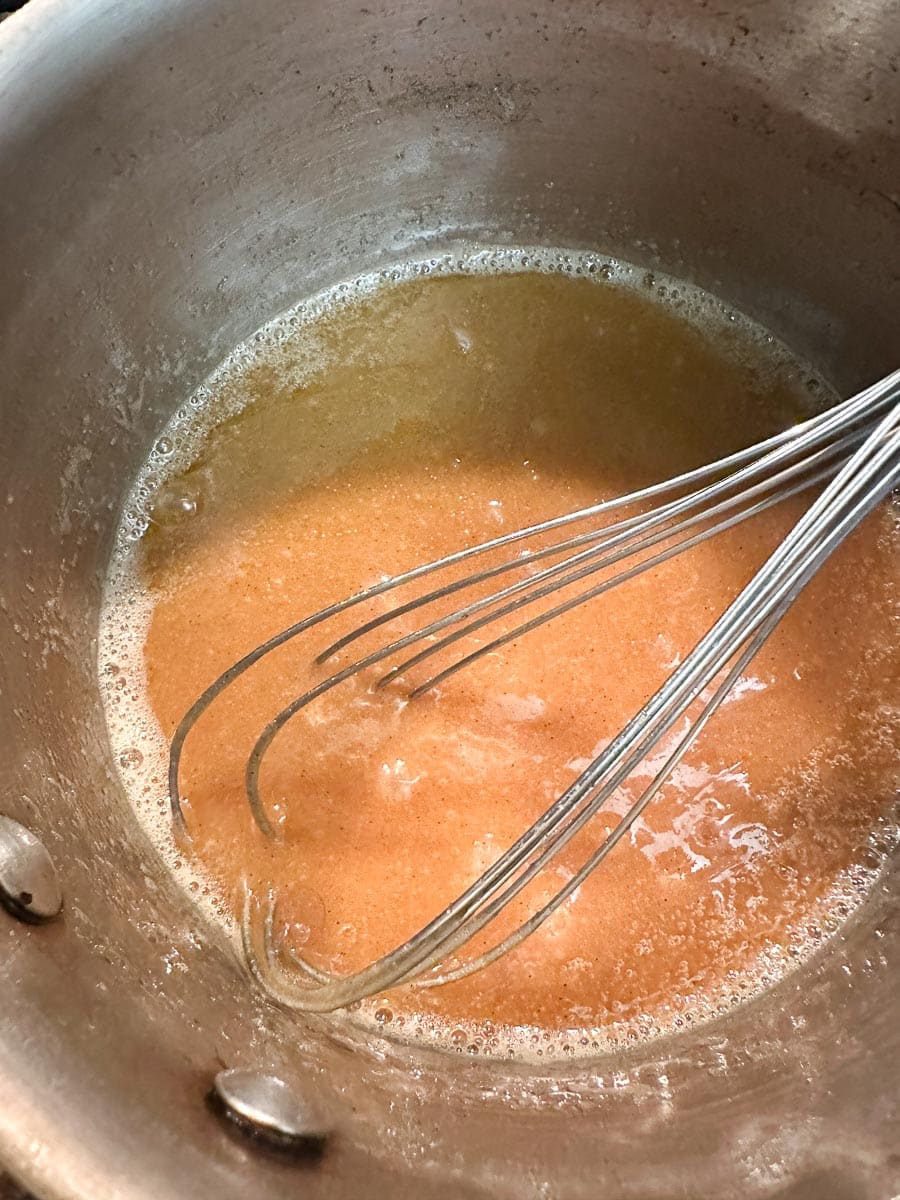
Pour into prepared pan.
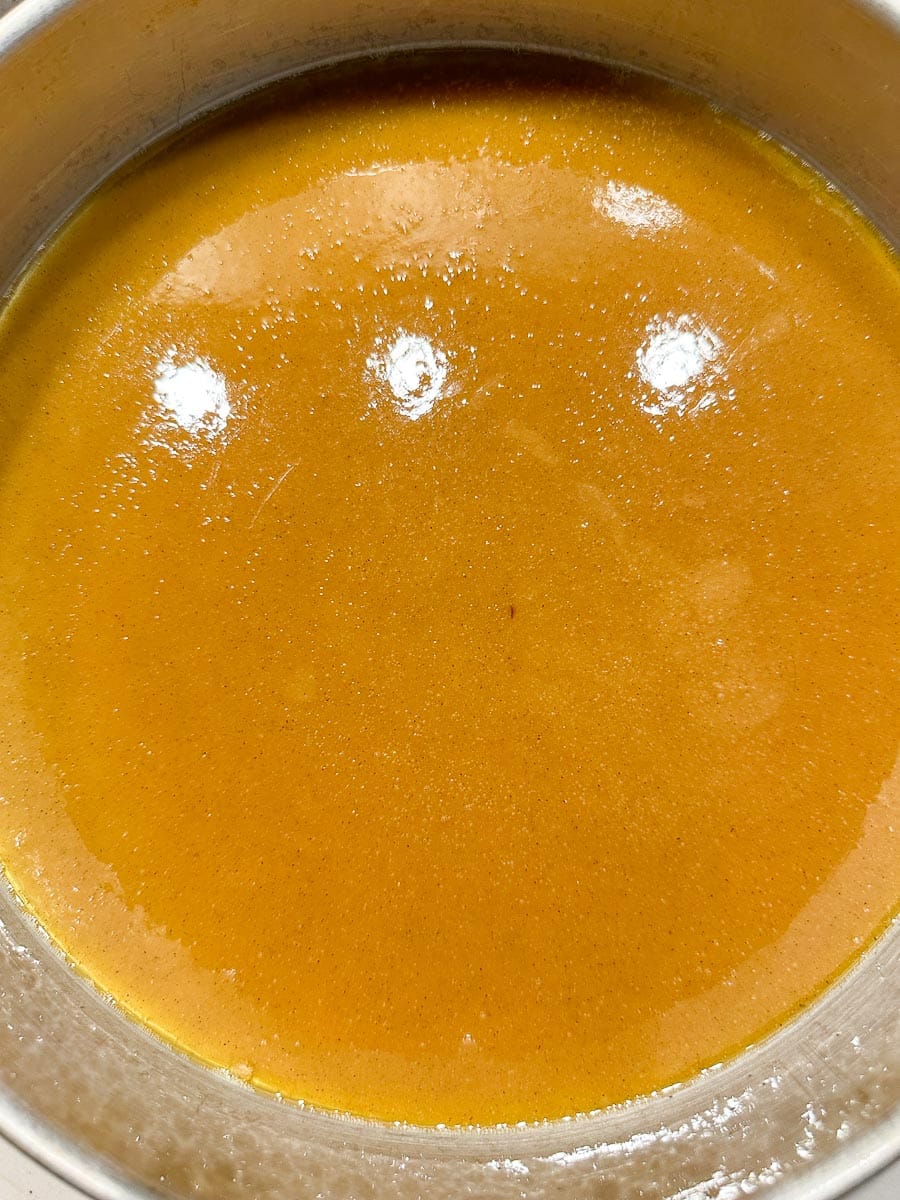
Arrange pears evenly over the topping in whatever decorative pattern you like.
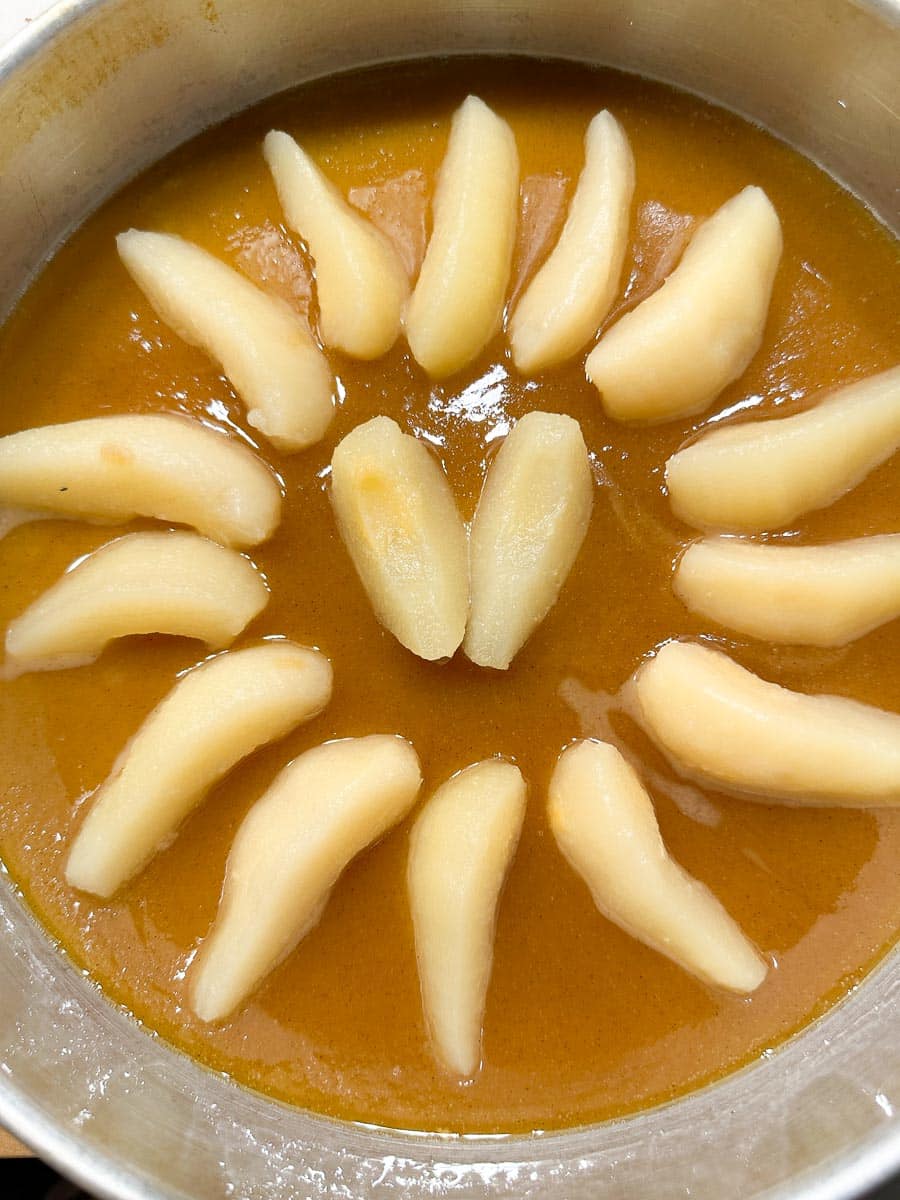
For the Cake: Whisk flour, optional candied ginger, baking soda, and salt together in a bowl; set aside.
Cream the butter using an electric mixer until lightened, then beat in brown sugar and continue beating for a couple of minutes until creamy.
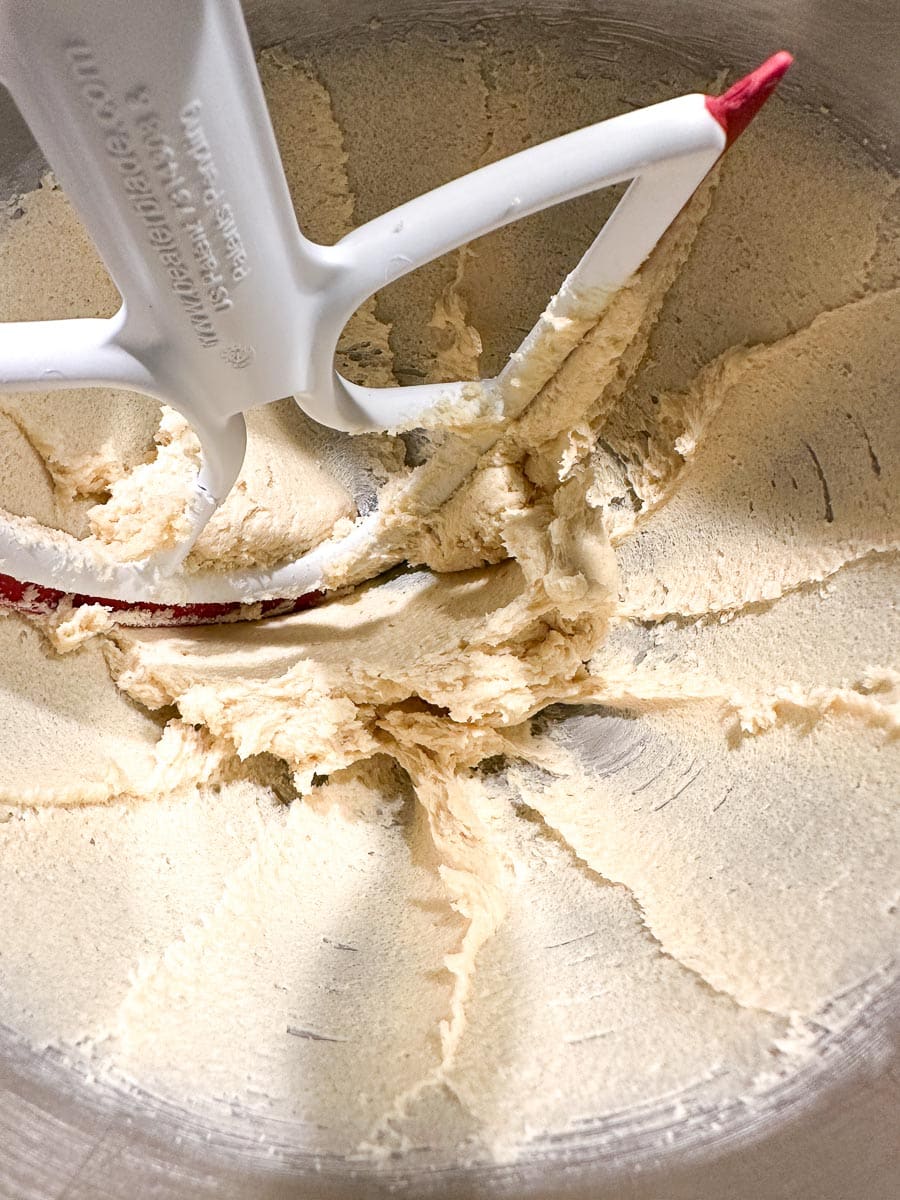
Meanwhile, whisk together the molasses and boiling water in a small bowl, then whisk in the cinnamon, ginger, allspice, and cloves; set aside.
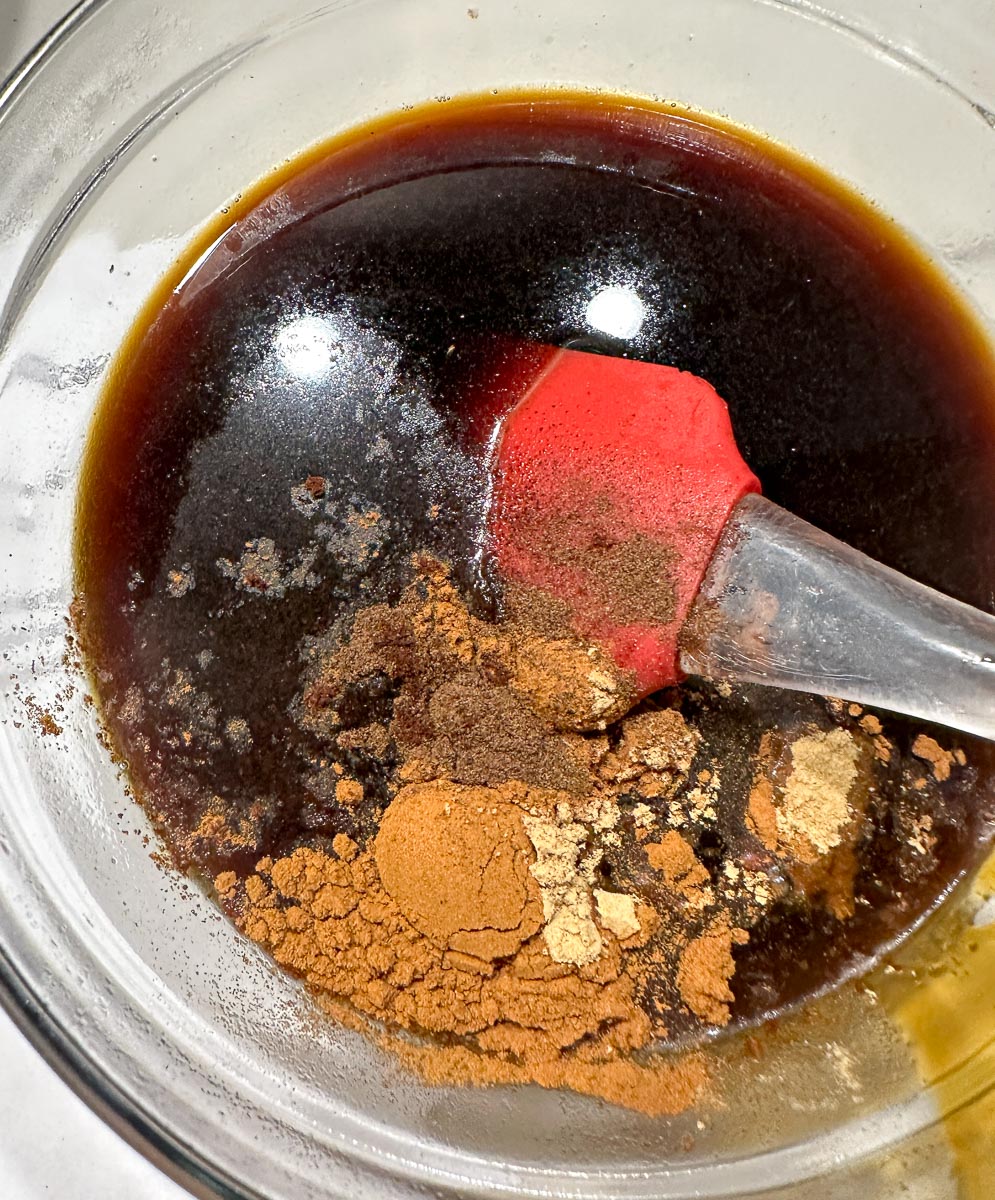
Scrape down the sides of the bowl of the butter/sugar mixture, beat in egg until combined, then beat in vanilla.
Add flour mixture and molasses mixture to the creamed butter/sugar alternately in three batches, beating the batter until ingredients are very well combined.
Gently pour batter on top of pears.
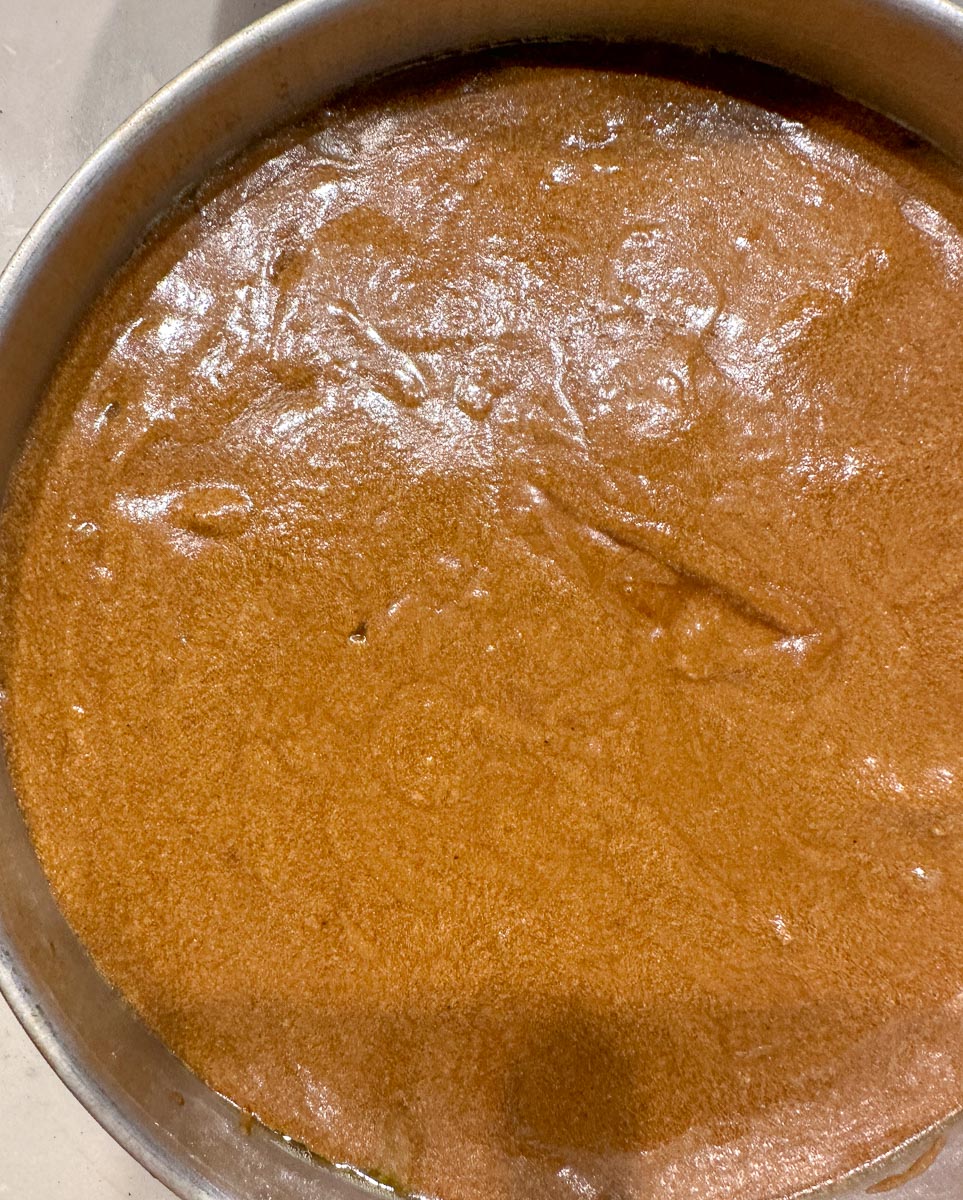
Bake for around 35 to 45 minutes or until the cake is beginning to pull away from pan’s sides and a toothpick inserted into the center of the cake comes out clean (no batter clinging).
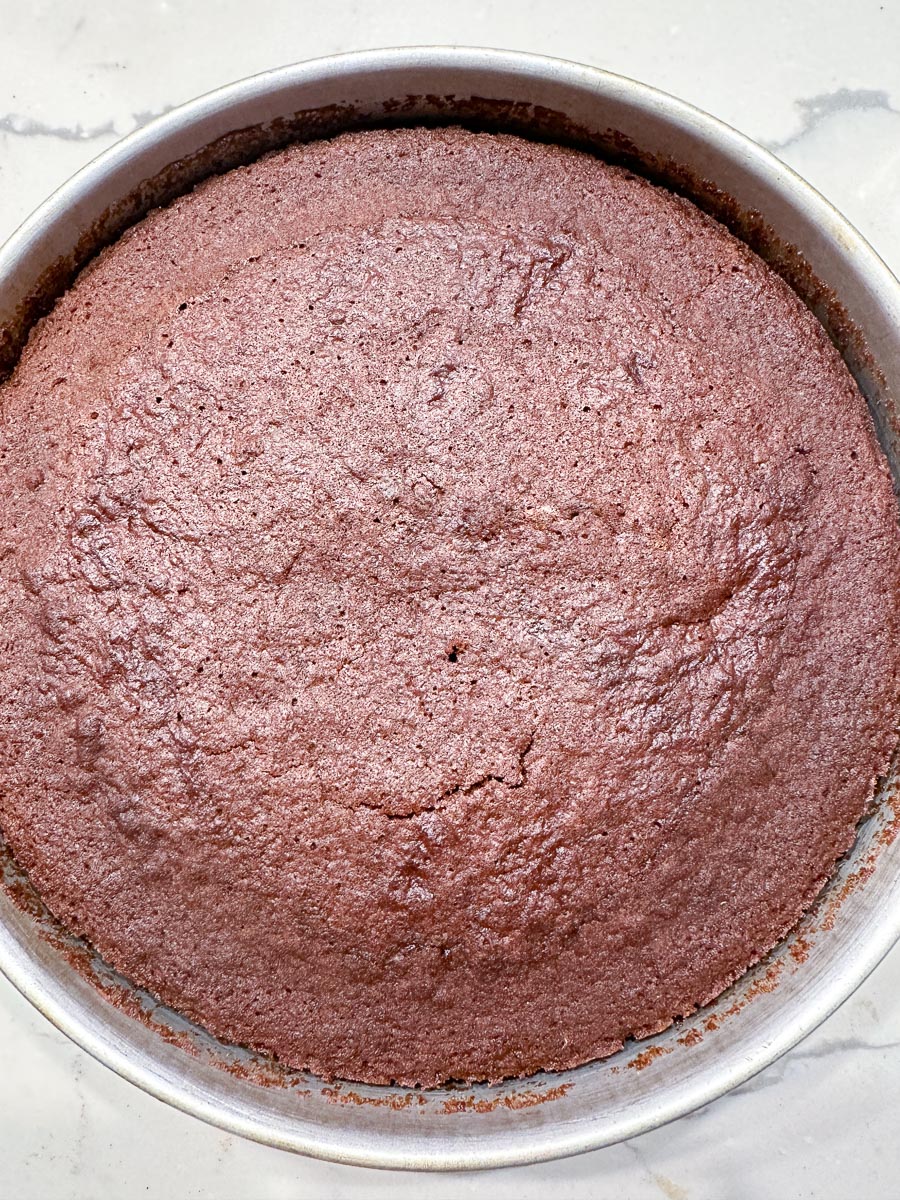
Remove from the oven and allow to cool in the pan for 10 minutes. Run a small icing spatula around the edges of the cake to loosen from pan, then invert cake onto a serving platter. If any pears or topping stick to the pan, just reapply them to the cake.
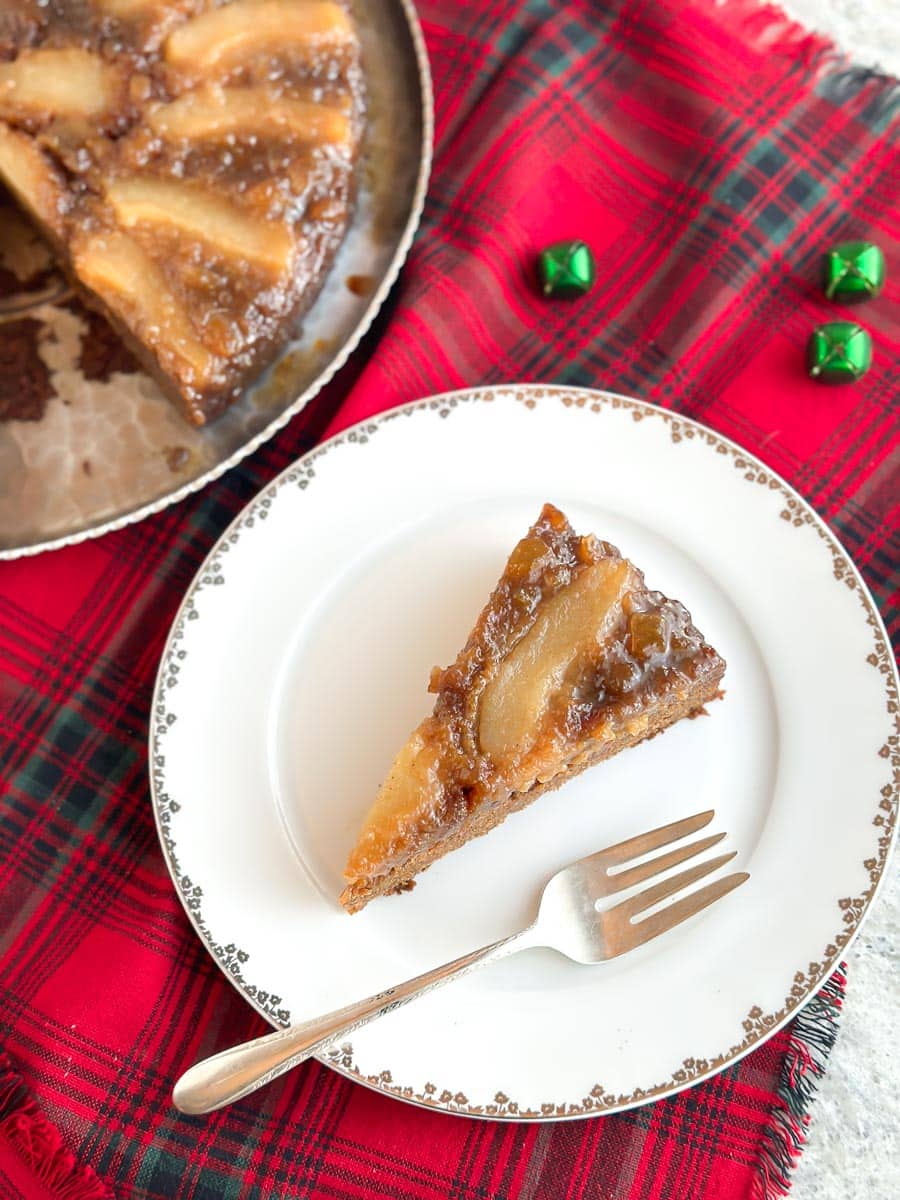
Cake is ready to serve or may be stores at room temperature in a cake dome overnight. This cake is lovely served warm or room temperature – and consider some optional whipped cream! Leftovers can be tightly wrapped and kept at room temp, but we think this cake is best within the first 24 hours.
FODMAP Information
All recipes are based upon Monash University & FODMAP Friendly science at time of initial publication.
- Brown Sugar: Brown sugar has been lab tested by both Monash University and FODMAP Friendly. There are many kinds of brown sugar, from cane to beet (to blends) to Muscovado and more, which we discuss in our Explore An Ingredient: Sugar. Unfortunately, there is no information about what kind of brown sugars were lab tested. Monash gives us a low FODMAP amount of ¼ cup or 40 g but no further information. In addition, in private correspondence with Monash University we know that there are amounts larger than 40 g that would be considered low FODMAP. FODMAP Friendly gives us a low FODMAP amount of 13 g. Dark brown Muscovado sugar does appear in a product lab tested and certified low FODMAP by FODMAP Friendly, so we do know there is a low FODMAP amount.
- Butter: Both Monash University and FODMAP Friendly have lab tested butter. Monash states that a low FODMAP Green Light portion is 1 tablespoon or 19 g and also states that “butter is high in fat and does not contain carbohydrates (FODMAPs)”. FODMAP Friendly gives it a “Pass” at 1 tablespoon or 19 g. Both recommended serving sizes are presented as part of healthy eating guidelines, not as maximum FODMAP serving size. Fat can affect guy motility and trigger IBS symptoms in some people. Eat to your tolerance.
- Eggs: Eggs are high in protein and do not contain carbohydrates, according to Monash University.
- Ginger: Monash University has lab tested fresh ginger root and has determined it to be free of FODMAPs, making it one of our go-to no FODMAP foods.
- Molasses: There is a lot of confusion surrounding molasses as it is on many high FODMAP lists. Monash University and FODMAP Friendly have both lab tested molasses. FODMAP Friendly has given it a “Fail” at 15 g, but Monash tested smaller portions and gives it as Green Light Low FODMAP serving size at 1 teaspoon or 5 g.
- Spices: Many fresh and dried spice have been lab tested by both Monash University and FODMAP Friendly and are easily looked up in the apps, which we strongly suggest that you have. The additional good news is that if you are interested in a spice that has not been lab tested, you can look at the nutritional panel and assess its FODMAP load for yourself. If the “Sugars” and/or “Carbs” are 1 g or less per serving, then the item would be a good bet to try.
Please always refer to the Monash University & FODMAP Friendly smartphone apps for the most up-to-date lab tested information. Foods will be retested from time to time; in the case of raw ingredients, such as fruits and vegetables, results may vary. All lab tested results are valid and represent a snapshot in time. As always, your tolerance is what counts; please eat accordingly. The ultimate goal of the low FODMAP diet is to eat as broadly as possible, without triggering symptoms, for the healthiest microbiome.
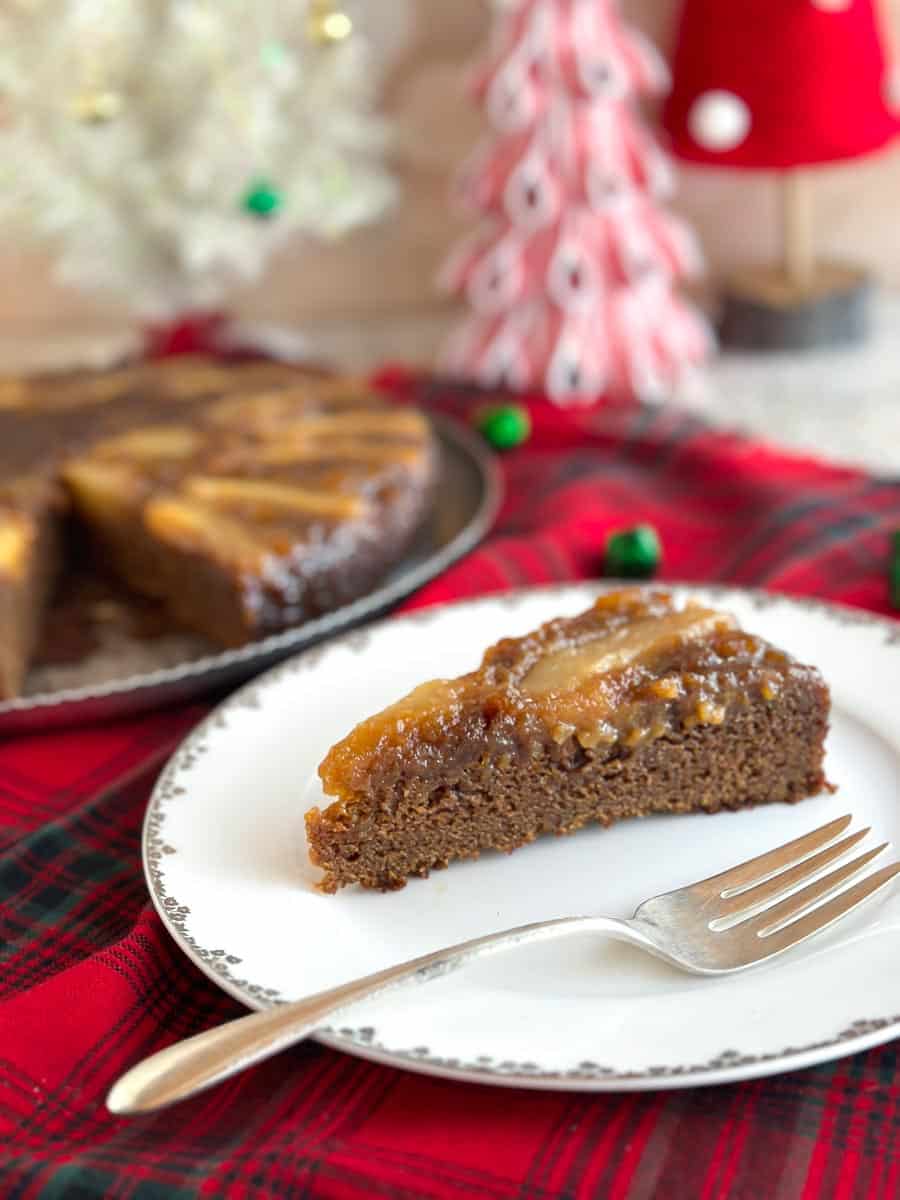
For More Gingerbread Recipes
We love the flavors of gingerbread. Check out these other low FODMAP gingerbread recipes.
- Gingerbread Caramel Crunch Popcorn
- Gingerbread Cookies
- Gingerbread Muffins
- Sticky Cranberry Gingerbread Cake
- Gingerbread Pancakes
- Gingerbread Streusel Pumpkin Cake
- Gingerbread Syrup
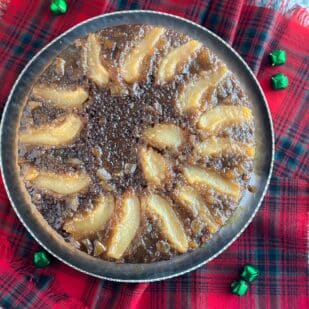
Lower FODMAP Gingerbread Pear Upside Down Cake
Our Lower FODMAP Gingerbread Pear Upside Down Cake combines a buttery brown sugar and pear topping, with a moist gluten-free gingerbread cake. This cake is not recommended for the Elimination Phase of the low FODMAP diet. Please note the icons at the top of the recipe; this cake is appropriate for those who digest fructose, sorbitol and fructans well as has been determined during your Challenge Phase.
Low FODMAP Serving Size Information: Makes 10-inch (25 cm) cake; 14 servings
Ingredients:
Pear Topping:
- ½ cup (1 stick; 113 g) unsalted butter, cut into pieces
- ½ cup (107 g ) firmly packed light brown sugar
- 1/8 teaspoon ground allspice
- 10- ounces (280 g) drained canned pears in pear juice, sliced into 1-inch (2.5 cm) wedges
Cake:
- 1 ¾ cups 254 g) low FODMAP, gluten-free all-purpose flour, such as Bob’s Red Mill 1 to 1 Gluten Free Baking Flour
- 2 tablespoons minced candied ginger, optional
- 1 teaspoon baking soda
- 1/4 teaspoon salt
- 1/2 cup (1 stick; 113 g) unsalted butter, at room temperature, cut into pieces
- 1/3 cup (71 g) firmly packed light brown sugar
- 1 large egg, at room temperature
- 1 teaspoon vanilla extract
- 3/4 cup (180 ml) unsulphured molasses
- 3/4 cup (180 ml) boiling water
- 1 1/2 teaspoons teaspoons ground cinnamon
- 1 1/2 teaspoons ground ginger
- ¼ teaspoon ground allspice
- ¼ teaspoon ground cloves
Preparation:
-
Position oven rack in middle of oven. Preheat oven to 350°F (180°C). Have a flat serving platter available that is at least 12-inches (30.5 cm) across.
-
For the Pear Topping: Coat a 10-inch (25 cm) round baking pan with nonstick spray. Place butter, brown sugar, and allspice in a small saucepan and melt and bring to a simmer over medium heat, stirring occasionally. Once it simmers, whisk vigorously for about 30 seconds to combine well. It should look a bit creamy. Pour into prepared pan. Arrange pears evenly over the topping in whatever decorative pattern you like.
-
For the Cake: Whisk flour, optional candied ginger, baking soda, and salt together in a bowl; set aside.
-
Cream the butter using an electric mixer until lightened, then beat in brown sugar and continue beating for a couple of minutes until creamy. Meanwhile, whisk together the molasses and boiling water in a small bowl, then whisk in the cinnamon, ginger, allspice, and cloves; set aside.
-
Scrape down the sides of the bowl of the butter/sugar mixture, beat in egg until combined, then beat in vanilla.
-
Add flour mixture and molasses mixture to the creamed butter/sugar alternately in three batches, beating the batter until ingredients are very well combined.
-
Gently pour batter on top of pears. Bake for around 35 to 45 minutes or until the cake is beginning to pull away from pan’s sides and a toothpick inserted into the center of the cake comes out clean (no batter clinging).
-
Remove from the oven and allow to cool in the pan for 10 minutes. Run a small icing spatula around the edges of the cake to loosen from pan, then invert cake onto a serving platter. If any pears or topping stick to the pan, just reapply them to the cake. Cake is ready to serve or may be stores at room temperature in a cake dome overnight. This cake is lovely served warm or room temperature – and consider some optional whipped cream! Leftovers can be tightly wrapped and kept at room temp, but we think this cake is best within the first 24 hours.
Notes:
FODMAP Information
All recipes are based upon Monash University & FODMAP Friendly science at time of initial publication.
• Brown Sugar: Brown sugar has been lab tested by both Monash University and FODMAP Friendly. There are many kinds of brown sugar, from cane to beet (to blends) to Muscovado and more, which we discuss in our Explore An Ingredient: Sugar. Unfortunately, there is no information about what kind of brown sugars were lab tested. Monash gives us a low FODMAP amount of ¼ cup or 40 g but no further information. In addition, in private correspondence with Monash University we know that there are amounts larger than 40 g that would be considered low FODMAP. FODMAP Friendly gives us a low FODMAP amount of 13 g. Dark brown Muscovado sugar does appear in a product lab tested and certified low FODMAP by FODMAP Friendly, so we do know there is a low FODMAP amount.
• Butter: Both Monash University and FODMAP Friendly have lab tested butter. Monash states that a low FODMAP Green Light portion is 1 tablespoon or 19 g and also states that “butter is high in fat and does not contain carbohydrates (FODMAPs)”. FODMAP Friendly gives it a “Pass” at 1 tablespoon or 19 g. Both recommended serving sizes are presented as part of healthy eating guidelines, not as maximum FODMAP serving size. Fat can affect guy motility and trigger IBS symptoms in some people. Eat to your tolerance.
• Eggs: Eggs are high in protein and do not contain carbohydrates, according to Monash University.
• Ginger: Monash University has lab tested fresh ginger root and has determined it to be free of FODMAPs, making it one of our go-to no FODMAP foods.
• Molasses: There is a lot of confusion surrounding molasses as it is on many high FODMAP lists. Monash University and FODMAP Friendly have both lab tested molasses. FODMAP Friendly has given it a “Fail” at 15 g, but Monash tested smaller portions and gives it as Green Light Low FODMAP serving size at 1 teaspoon or 5 g.
• Spices: Many fresh and dried spice have been lab tested by both Monash University and FODMAP Friendly and are easily looked up in the apps, which we strongly suggest that you have. The additional good news is that if you are interested in a spice that has not been lab tested, you can look at the nutritional panel and assess its FODMAP load for yourself. If the “Sugars” and/or “Carbs” are 1 g or less per serving, then the item would be a good bet to try.
Please always refer to the Monash University & FODMAP Friendly smartphone apps for the most up-to-date lab tested information. Foods will be retested from time to time; in the case of raw ingredients, such as fruits and vegetables, results may vary. All lab tested results are valid and represent a snapshot in time. As always, your tolerance is what counts; please eat accordingly. The ultimate goal of the low FODMAP diet is to eat as broadly as possible, without triggering symptoms, for the healthiest microbiome.
Nutrition
All nutritional information is based on third-party calculations and should be considered estimates. Actual nutritional content will vary with brands used, measuring methods, portion sizes and more. For a more detailed explanation, please read our article Understanding The Nutrition Panel Within Our Recipes.







